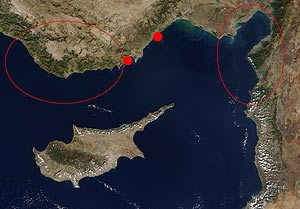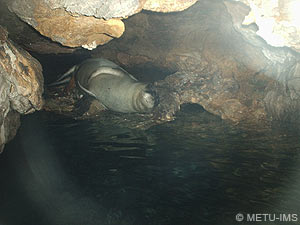

 |
||
 |
||
Vol. 7 (2): November 2004 |
Download this article
|
|
IS THE BROKEN LINK BETWEEN TWO ISOLATED COLONIES IN THE NORTHEASTERN MEDITERRANEAN RE-ESTABLISHING?Ali Cemal GucuMiddle East Technical University
|
 |
|
|
Survey areas circled in red. Left: the Cilician coast. Right: the Gulf of Iskenderun. Red dots mark the location of formerly abondoned and recently re-populated caves. |
The research team had 5 tasks in the survey: i) checking all seal habitats (mainly caves) known in the area; ii) sailing along the transects in search of seals; iii) exploring new habitats; iv) collecting images via in-cave camera traps and v) collecting recent seal sighting information from the locals on either side of the study area.
A total of 39 caves, including 4 in which at least a pup was found by the research team earlier, were checked in the survey. Although fresh haul-out trails conspicuously signified active use in all breeding caves, whelping occurred only in a single cave, which had not been used for breeding until last year (see The Cilician Monk Seal Colony is Growing, TMG 6 (2): December 2003). Since the breeding season in the Cilician colony may extend to mid-November (Gucu et al. 2004), the timing of the survey might have been premature, and there may still be hope of finding more recruits to the colony during the coming survey in late November 2004.
As yet, the infrared camera traps in the Gulf failed to catch Arab. Moreover, he did not show up during the survey on the west coast of Mersin. Instead, a young female, displaying rather few mating scars on her back, was sighted during the observation in an area designated ‘abandoned seal habitat’ located between Cilicia and the Gulf of Iskenderun. The brief survey on this coast indicated that a cave which had not been used in the last 10 years, and hence recorded as “abandoned” in the cave inventory, has since been frequented at least by the young female. This is, in fact, one of two caves found to be in use by the seals, though both were known as “abandoned” before the survey. Both caves are located outside the colony’s distribution site described earlier (Gucu et al. 2004).
 |
|
|
A young female seal caught by the in-cave camera trap. So far, Arab “the Pilgrim” has not been caught on camera. |
Furthermore, the female seal sighted in the area was seen to make suspiciously slow movements, especially when diving. Her bloated belly, recognized in the inspection of underwater images, allows us to hope that she might be pregnant.
In the first habitat exploration survey carried out in the Gulf of Iskenderun in October 2003, none of the caves discovered had appropriate characteristics for whelping, such as a wide and long platform in a well sheltered air chamber having a calm inner training pool. Lack of a proper breeding cave was one of the reasons that led us to the premature conclusion that the area might never have hosted a large, resident and isolated seal colony. In the last field survey, however, a cave having suitable characteristics for breeding was finally discovered and obliged us to reconsider our conclusion.
Besides, the seal sighting reports accumulated through the information network established among the locals have indicated that the occurrence of seals within the Gulf of Iskenderun is not sporadic as thought earlier, but covers the whole year. That may also indicate existence of a small segregated group of seals inhabiting the Gulf. The number of sightings, however, is not high enough to expect a large colony in the region.
It is very likely that there was one single and large seal population in the past covering the entire extent of the northeastern Mediterranean. Later, because of intensive urbanization and industrialization within their habitat, and also because of deliberate killings, the population became fragmented into small isolated colonies by the early 1980s. Today, the seals dispersed to Syria, Cyprus, the Gulf of Iskenderun and all along the northeastern Mediterranean may be the relicts of the same historical population. Depending on the level of disturbance and the size of the fragments, some groups may maintain their biological and social functions, as on the Cilician coast. Due to steep and mountainous topography on the west coast of Mersin, human pressure and, in turn, habitat fragmentation, has not been as severe as on the east coast, as indicated by continued reproductive ability of the colony inhabiting there. However, the fate of the small colony in the Gulf of Iskenderun is uncertain, especially when the genetic bottleneck is considered — i.e. the probability of extinction may increase due to reduced genetic variability.
The evaluation of survey results, however, reveals that the situation in the eastern Mediterranean is not as bad as first feared — and may even be promising. It is evident that the colony on the west coast of Mersin is increasing, and is also following an expanding trend. The caves recently repopulated by the seals are located right in the middle of the two fragmented colonies. At the moment we are not sure if there is sufficient genetic movement between these fragments. However, if the young female breeds in these caves and establishes a new family (= sub-group) in the area, that will certainly be a bridge between two isolated colonies. In fact, it seems that this is the only chance of the small colony in the Gulf of Iskenderun to survive.
Gucu, A.C., G. Gucu and H. Orek. 2004. Habitat use and preliminary demographic evaluation of the critically endangered Mediterranean monk seal (Monachus monachus) in the Cilician Basin (Eastern Mediterranean). Biological Conservation 16 (3): 417-431. [Abstract]
Copyright © 2004 Ali Cemal Gucu, The Monachus Guardian. All Rights Reserved |